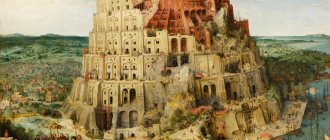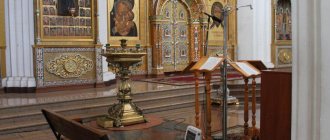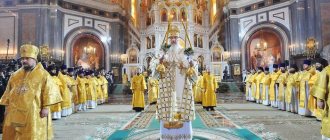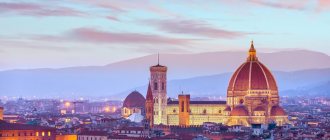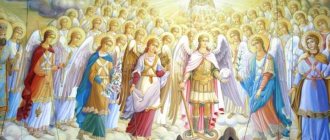Icon as a word is of Greek origin and literally means “image”. Byzantium is considered the birthplace of the icon; it was from there that this “image” came to Rus'.
Interestingly, in the early Christian tradition there was no rule to create man-made images of the Almighty. This was explained by one of the commandments of the Old Testament, prohibiting “making an idol,” as well as the direct connection of such images with pagan worship. The first apologists of Christianity completely denied any possibility of depicting God; this tradition still remains in other Abrahamic religions (Islam, Judaism).
Meanwhile, under these conditions, it was considered acceptable to use appropriate symbols that “remind” believers of the basic ideas and images of Christianity, which, however, remained understandable only to them. Thus, in the catacombs, which served as “temples” for the first Christians, the walls were decorated with special images, among which there were, for example, symbols:
- Baskets with loaves that stand on fish are a symbol of the miracle of multiplying the loaves and feeding a thousand people with 5 loaves and two fish
- Grapevine - like the Lord's planting
- Dove, ship, etc.
Gradually, images of God as an anthropomorphic (i.e. human-like) image begin to appear. Along with them, an intellectual dispute and struggle arises and intensifies, called the process of clash between icon-worshipers and iconoclasts. Historically, this is the period of the 8th-9th centuries, when the ban on the veneration of icons was formalized first by the secular authorities (Byzantine Emperor Leo III), and then by the church (Council of 754).
As a result of this struggle, icon veneration was also officially permitted by the authority of the Council of 843. This was not done “from scratch”; by that time the theologians of Byzantium had managed to develop a whole harmonious system, which was included in the corresponding theory of the icon. Among these titans of thought are Theodore the Studite and John of Damascus, who are now the “fathers of the church.”
Christian icon theory
The icon as the image of God was recognized as a symbol and declared to be a mediator between man and the invisible world.
The images had their own hierarchy:
- God is the prototype
- Logos (as the realized word of God) – the second type of images
- Man is the third species
The main question is how can one depict the invisible God? According to legend, we know that God appeared to the elders and prophets as a heavenly light, a burning bush, or in the form of three travelers. This is an Old Testament tradition. In New Testament history, we know another image of God - this is the Son of the Lord, who appeared in the world in the form of a man. This image was allowed to be used in icons, when the supernatural, heavenly, divine appears before us through the embodied human. That is, permission to venerate icons was based on the main dogma of the incarnation of Christ.
God the Father himself was never depicted by Byzantine icon painters, but in the European part and in Rus' there were icons where the first person of the Trinity could be represented by a gray-haired old man.
However, it was in Byzantium that by the 10th century the symbolism of the icon, its genres, and types of iconography began to take shape.
Canon of Christian icon
Canonicity can be called the main feature or feature of an icon. Since this image was to be used in church practice and to establish a connection between man and God, everything in it had to be subject to the same “rules”, i.e. canon. This canon was determined primarily by the theological content component, and only then by aesthetics. Image composition, icon shapes, color, accessories, etc. were determined by dogma, which made them understandable to all believers.
Such canonical provisions did not appear directly with the emergence of Christianity; on the contrary, ancient cultures knew about them to one degree or another. The art of Egypt was characterized by a high level of canonicity; the canon was also present in ancient culture, but in smaller scale meanings.
In Christian culture, the canon also provided a sufficient average level of execution of the icon; image samples were verified, selected and accessible; nothing had to be “invented” or “authorly” developed, since there were already stable models of iconographic images. Among other things, in the Middle Ages the master did not even sign the work; all icons were created by “anonymous people.”
The iconographic canon extended to the following elements:
The plot and composition of the image on the icon
The plot of the icon corresponded to Scripture; the choice of the content element was left to the church. To implement this or that order, the icon painter had samples, slits and so-called “Explanatory Originals”, in which the entire image was already presented and specified. It was by these subject-compositional “standards” that believers recognized the icon and could distinguish between them in essence.
It is interesting that in Rus', already from the 12th century, the Byzantine canon began to undergo national “modernization”, when stable types of iconography “modified” or even new ones of their own appeared, determined by local traditions. This is how the canon of the Intercession of the Virgin Mary arose, for example, or icons with images of saints of a certain area.
Figure on the icon
Canonically, the depiction of the figure was also strictly “regulated.” Thus, the main (or semantically main) figure had to be located frontally, i.e. facing the believer. It was given motionless and large. Such a figure was the “center” of the icon. Less significant figures in this plot were presented in profile, they were characterized by movement, complex pose, etc. If there was a person on the icon, then he was depicted as an elongated figure with an emphasis on the head. If it was a person’s face, then the upper part of the face with emphasis on the eyes and forehead stood out. In this way, the predominance of the spiritual over the sensual was emphasized. In contrast, the man’s mouth was depicted as disembodied, his nose thin, and his chin small. In the images of saints, their name was written next to the face.
Iconography and canon
Anyone who begins to look at icons inevitably wonders about the content of ancient images, about why for several centuries the same plot remains almost unchanged and easily recognizable. Iconography, a strictly established system for depicting certain characters and religious subjects, will help us find the answer to these questions. As church ministers say, iconography is “the ABC of church art.”
Iconography includes a large number of subjects taken from the Old and New Testaments of the Bible, theological works, hagiographic literature, and religious poetry on the themes of basic Christian dogmas, that is, canons.
The iconographic canon is a criterion for the truth of an image, its correspondence to the text and the meaning of the “Holy Scripture”.
Centuries-old traditions and the repetition of compositions of religious subjects led to the development of such stable patterns. Iconographic canons, as they were called in Russia - “izvody”, reflected not only general Christian traditions, but also local features inherent in one or another art school.
Constancy in the depiction of religious subjects, in the immutability of ideas that can only be expressed in the appropriate form - this is the secret of the canon. With its help, the symbolism of the icon was consolidated, which in turn facilitated the work on its visual and meaningful side.
The canonical foundations covered all the expressive means of the icon. The compositional scheme recorded the signs and attributes inherent in an icon of one type or another. Thus, gold and white symbolized divine, heavenly light. Usually they celebrated Christ, the heavenly powers, and sometimes the Mother of God. Green color denoted earthly blossoms, blue - the celestial sphere, purple was used to depict the clothes of the Mother of God, and the red color of Christ's clothes denoted his victory over death.
The main characters of religious painting are the Mother of God, Christ, the Forerunner, apostles, prophets, forefathers and others. Images can be main, shoulder, waist and full-length.
The image of the Mother of God was especially loved by icon painters. There are more than two hundred types of iconographic images of the Mother of God, the so-called “izvods”. They have names: Hodegetria, Eleusa, Oranta, Sign and others. The most common type of image is Hodegetria (Guide Book), (Fig. 1). This is a half-length image of the Mother of God with Christ in her arms. They are depicted in a frontal spread, looking intently at the person praying. Christ rests on Mary’s left hand; she holds her right hand in front of her chest, as if pointing it at her son. In turn, Christ blesses the worshiper with his right hand, and in his left hand he holds a paper scroll. Icons depicting the Mother of God are usually named after the place where they first appeared or where they were especially revered. For example, the icons of Vladimir, Smolensk, Iverskaya, Kazan, Georgian and so on are widely known.
Another, no less famous, type is the image of the Mother of God called Eleusa (Tenderness). A typical example of an icon of the Eleus type is the widely known and beloved by all believers Our Lady of Vladimir. The icon is an image of Mary with a baby in her arms. In the entire appearance of the Mother of God one can feel maternal love and complete spiritual unity with Jesus. This is expressed in the tilt of Mary's head and in the gentle touch of Jesus on his mother's cheek (Fig. 2).
An impressive image of the Mother of God, known as Oranta (Prayer). In this case, she is depicted without Jesus, with her hands raised up, which means “standing before God” (Fig. 3). Sometimes a “circle of Glory” is placed on Oranta’s chest, in which Christ is depicted as an infant. In this case, the icon is called “Great Panagia” (All Holy). A similar icon, but in a half-length image, is usually called the Mother of God of the Sign (Incarnation). Here the disk with the image of Christ denotes the earthly being of the God-man (Fig. 4).
Images of Christ are more conservative than images of the Mother of God. Most often, Christ is depicted as Pantocrator (Almighty). He is depicted frontally, or waist-length, or in full growth. At the same time, the fingers of his right, raised hand are folded in a blessing gesture with two fingers. There is also an addition of fingers, which is called “nominal”. It is formed by the crossed middle and thumb fingers, as well as the extended little finger, symbolizing the initials of the name of Christ. In his left hand he holds an open or closed Gospel (Fig. 5).
Another, most common image is “The Savior on the Throne” and “The Savior in Power” (Fig. 6).
The icon called “Savior Not Made by Hands” is one of the oldest, which depicts the iconographic image of Christ. The image is based on the belief that the imprint of Christ’s face is imprinted on a towel – ubrus. In ancient times, the Savior Not Made by Hands was depicted not only on icons, but also on banners, which Russian soldiers took on military campaigns (Fig. 7).
Another common image of Christ is his full-length image with a blessing gesture with his right hand and the Gospel in his left - Jesus Christ the Savior (Fig. 8). You can often see an image of the Almighty in the robes of a Byzantine emperor, which is usually called “The King of the King,” meaning that he is the King of all kings (Fig. 9).
Interesting information about the nature of the clothes and vestments in which the characters of the icons dress. From an artistic point of view, the clothing of iconographic characters is very expressive. As a rule, it is based on Byzantine motifs. Each image has clothes that are characteristic and unique to it. Thus, the clothing of the Mother of God is a maforium, a tunic and a cap. Maforium is a blanket that envelops the head, shoulders and goes down to the floor. It has a border decoration. The dark cherry color of maforia means a great and royal family. Maforius wears a tunic - a long dress with sleeves and ornaments on the cuffs (“arms”). The tunic is painted dark blue, which symbolizes chastity and heavenly purity. Sometimes the Mother of God appears in the clothes not of Byzantine empresses, but of Russian queens of the 17th century.
On the head of the Mother of God, under the maforium, a green or blue cap is drawn, decorated with white stripes of ornament (Fig. 10).
Most of the female images in the icon are dressed in a tunic and cloak, fastened with a fibula clasp. A headdress is depicted on the head.
A long dress is worn over the tunic, decorated at the bottom with a hem and an apron going from top to bottom. This clothing is called dolmatic.
Sometimes, instead of a dolmatic, a table can be depicted, which, although similar to a dolmatic, does not have an apron (Fig. 11).
Christ's robe includes a tunic, a long shirt with wide sleeves. The chiton is colored purple or red-brown. It is decorated with two parallel stripes running from the shoulder to the hem. This is a clavius, which in ancient times denoted belonging to the patrician class. A himation is thrown onto the tunic. It completely covers the right shoulder and partially the left. The color of the himation is blue (Fig. 12).
Folk clothing is decorated with a mantle embroidered with precious stones.
On icons of a later period one can also see civilian clothing: boyar fur coats, caftans and various attire of commoners.
Reverends, that is, monks, are dressed in robes, robes, schemas, hoods, and so on. On the heads of the nuns, an apostle (cape) was depicted, covering the head and shoulders (Fig. 13).
Warriors are depicted in armor, with a spear, sword, shield and other weapons (Fig. 14).
When writing kings, their heads were decorated with a crown or crown (Fig. 15).
Fragment of the icon “Our Lady of Tenderness”. Linden, pavoloka, gesso, tempera. First half of the 15th century. Tretyakov Gallery.
Color in Russian iconography
The symbolism of color in icon images is also strictly canonical. Meanwhile, the Russian tradition of iconography is characterized by an unusually bright and rich palette and color scheme.
The Byzantine tradition is characterized by the essential supremacy of the golden color, which was supposed to reflect the divine light itself. In such icons, both the background and important details of the image - halos, cross, etc. - were covered with gold. On Russian icons, gold will be replaced with paints, and purple (the power of the emperor), which was very significant in Byzantium, will not be used at all.
The red color on our icons will be most widely used in the Novgorod school, where the background will be covered with red, replacing Byzantine gold. In terms of content, it will symbolize the color of the Redeemer’s blood, the flame of life.
For white color, the meaning of divine light and innocence was prescribed; it was used in the clothes of both Christ and the righteous and saints.
For blacks, the content was determined by the symbols of death and hell; in general it was used very rarely and, if necessary, could be replaced by dark tones of blue or brown.
Green was the color of the earth (predominant in the Pskov school of icon painting), this color seemed to be opposed to heavenly or royal.
Blue is a symbolism of the sky, eternity, and had the meaning of truth. Both the Savior and the Mother of God could have been dressed in blue robes.
Space in an icon
The arrangement of figures and the construction of the image space itself is another important component of the canon. Today we know about three types of planar display of space available in art. These are the prospects:
- straight line (concentric space). Characteristic of the Renaissance period, expresses the active position and point of view of the artist
- parallel (static space). The image is located along the canvas, typical of oriental art and Ancient Greece
- reverse (eccentric space). Chosen as canonical for icon painting
This perspective reflected the essence of dogmatic positions, when the icon was understood not as a window into the real world, like a Renaissance painting, but as a way of “manifesting” the heavenly world. Here it is not the artist who looks at what he depicts, but the character of the icon who looks at the believer. The space itself is symbolic:
- a hill can represent a mountain,
- a bush is a whole forest,
- the bulbs of churches - a whole city.
An icon can thus have a vertical line that connects earth and sky; So in the lower part of the image the mobile, changeable, human is given, and in the upper part - eternity, the heavenly world.
Appearance and pose
The appearance of all the saints, the clothes in which they should be written, the poses in which they
can accept, strictly defined. Thus, the Apostle John Chrysostom follows
portrayed as fair-haired and with a short beard, and St. Basil as dark-haired with
long pointed beard. See also Iconography of Our Lady, Iconography
Christ.
“Flattening”, ignoring linear perspective
Any transfer of volume is undesirable, as it draws attention to the body
the essence of what is depicted to the detriment of the spiritual essence. The figures become
two-dimensional. For the same purpose, the previously widely used encaustic technique
, giving a too “tactile” surface is replaced by a dry and strict one
tempera
Naturally, flat figures are inappropriate on a landscape or architectural background,
which implies perspective and the transfer of volume. Ideally the landscape disappears
and gives way to the background, and the empty space is filled with inscriptions - the name
saint, in the words of divine scripture.
The linear perspective of antiquity (“straight” perspective) was lost. Her
the place was taken by the so-called “reverse” perspective (when the lines converge beyond
the picture, in its imaginary depth, and in front of it, as if in the eyes of the viewer).
Now the artist painted not the object itself, but rather the idea of the object. At the five-headed
temple, for example, all five domes were lined up in a straight line, without taking into account
the fact that in reality two chapters would be obscured. The table should have
four legs are depicted, despite the fact that the hind legs are not visible. Item
on the icon it should be revealed to a person in its entirety, the way he is
accessible to the Divine Eye.
